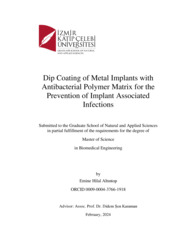Dip Coating of Metal Implants with Antibacterial Polymer Matrix for the Prevention of Implant Associated Infections
-
Eser Sahibi
Emine Hilal Altıntop
- Tez Danışmanı Didem Şen Karaman
-
Tür
Yüksek Lisans
- Yayın Tarihi 2024
-
Yayıncı
İzmir Katip Çelebi Üniversitesi Fen Bilimleri Enstitüsü
- Tek Biçim Adres https://hdl.handle.net/11469/3883
-
Konu Başlıkları
Dip coating
QAS
Daldırma Kaplama
The recent increase in life expectancy and changing living conditions have led to a
rise in developments regarding implants, particularly in orthopedic implants. It is
important to note that this statement is based on objective evidence and not
subjective evaluations. Despite these advances, issues with metallic implants such as
Ti, Ti alloy, Co-Cr alloy, and stainless steel (AISI 316L), which are currently
preferred, persist. There are several limitations to implant materials, including
corrosion due to the physiological environment, bacterial infection, and biofilm
formation. Although these limitations have not been extensively studied, they
prevent the attainment of the desired level of implant material and result in a lifespan
of approximately 20 years for currently used implants.
Despite their biocompatibility and biohardness, implant-related infections can occur
due to bacterial colonization. Staphylococcus aureus is known to colonise foreign
bodies and increase the risk of implant-related infection. Infections caused by S.
aureus can delay the healing process, cause bone loss, and require long-term
antibiotic use. It is widely accepted that 40% of S. aureus strains are resistant to
antibiotics. The development of drug resistance can increase and lead to implant
replacement, which may result in infections and even death. Negative changes in
implant performance often occur due to reactions between the implant and
surrounding tissue, which are caused by the physical and chemical properties of the
implant surface. Therefore, modifying the surface properties of materials, both
chemically and physically, shows great potential in improving implant integration.
Additionally, with the rise of antibiotic-resistant infections and limited treatment
options, there is growing interest in integrating antibacterial properties into
biomaterials.
Coating technologies are preferred for overcoming the limitations associated with
implants. These include plasma spraying, biomimetic deposition, electrochemical
deposition, electrophoretic deposition, and sol-gel coating. The primary goal of these
coating technologies is to increase biocompatibility and create an antibacterial effect.
Complex organic, inorganic, or hybrid materials, using a combination of these two,
are preferred for implant coatings. Polymers and metal/metal oxide nanoparticles are
examples of organic and inorganic materials, respectively.
This study aims to create a surface coating for K-Wires using the dip coating or solgel method. The coating matrix use polyvinyl alcohol (PVA) due to its economic and
solubility advantages. PVA is a preferred polymer for implant surface adhesion.
Quaternary ammonium silanes (QAS) are inorganic materials that possess
antibacterial properties. When combined with PVA, these hybrid materials can
provide antimicrobial properties without the need for additional binders. Due to their
low toxicity and antibacterial properties, QAS can be a preferred material for
preventing post-implantation infections.
-
Koleksiyonlar
ENSTİTÜLER
FEN BİLİMLERİ ENSTİTÜSÜ



